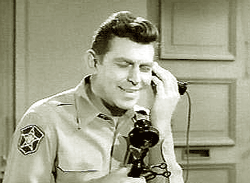Van Nuys
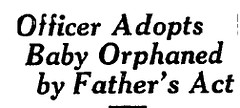 One August night in 1927, Edgar Burnett of Van Nuys shot his wife, then turned the gun on himself, leaving their four children orphaned. The children were separated, and taken in by different families. Eleanor Ray Burnett, 7, was adopted by a wealthy Anaheim family; Ermie Jean, 3, was sent to Toronto to live with Miss Myrtle Hendrie; and Edgar Jr., 16 months, went to a Van Nuys family.
One August night in 1927, Edgar Burnett of Van Nuys shot his wife, then turned the gun on himself, leaving their four children orphaned. The children were separated, and taken in by different families. Eleanor Ray Burnett, 7, was adopted by a wealthy Anaheim family; Ermie Jean, 3, was sent to Toronto to live with Miss Myrtle Hendrie; and Edgar Jr., 16 months, went to a Van Nuys family.
And today, the Burnett’s newborn daughter, Nona Lee, was adopted by Patrolman James Hayden of the Van Nuys police station and his wife. Nona was only 5 days old at the time of the killings, and the babe had been in her mother’s arms when Edgar Burnett fired the fatal shots. In 1927, it was reported that the Hayden’s would rear Nona "never to know the tragedy of her early life," or about her brother and sisters.
However, at some point, the Hayden’s must have decided to tell Nona the truth about her past. And it seems a good thing they did.
You see, on Halloween night, 24 years later, 24-year-old Louis Shandra wrote a note, and went to his estranged wife’s apartment. The note read, "I am going to kill my wife and myself tonight. I love her more than anything else in the world."
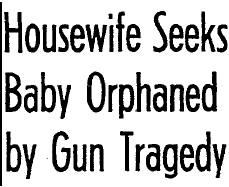 Shandra had recently served 30 days for beating his wife, Carmela, who had moved into her own place while Shandra was in jail. He went to the apartment at 808 E. Palmer Ave., Glendale, and shot Carmela to death with a rifle in front of the couple’s 2-year-old son, Bobby. Then, Shandra went into another apartment in the building, and killed himself.
Shandra had recently served 30 days for beating his wife, Carmela, who had moved into her own place while Shandra was in jail. He went to the apartment at 808 E. Palmer Ave., Glendale, and shot Carmela to death with a rifle in front of the couple’s 2-year-old son, Bobby. Then, Shandra went into another apartment in the building, and killed himself.
A Ventura housewife married to Deputy Sheriff Warren Paul read about the tragedy in Glendale, and was so moved that she and her husband offered to adopt the child themselves. Nona Hayden Paul told the Los Angeles Times the circumstances of her early childhood and said, "I wondered what would happen to that poor little boy. I talked to my husband about it and we’ve decided we’d love to raise him on our own." Warren Paul agreed readily – he, too, had been adopted as a child.


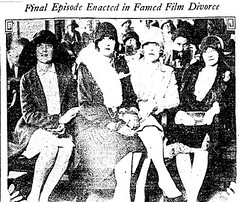 Hollywood divorces may be ugly today, but the dissolution of the legal bonds between Charlie Chaplin and his child bride, Lita Grey, may have been nastier than K-Fed and Britney, Alec and Kim, and Loni and Burt put together.
Hollywood divorces may be ugly today, but the dissolution of the legal bonds between Charlie Chaplin and his child bride, Lita Grey, may have been nastier than K-Fed and Britney, Alec and Kim, and Loni and Burt put together.
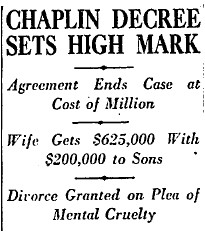 In her nearly 50-page formal complaint against Chaplin, Grey leveled the following accusations: he’d forced her to have sex with him before they were married; he’d told her to get an abortion when he discovered she was pregnant; on their way back to Los Angeles after their wedding, he told her, “This marriage won’t last long. I’ll make you so — sick of me that you won’t want to live with me”; accused her of forcing him into marriage; had an affair with a prominent motion picture actress; told her she was stupid; encouraged her to commit suicide; only took her out 3-4 times during the first two months of their marriage “for the sake of appearances”; left her alone on Christmas while he went out and got drunk; threatened her life twice with a loaded revolver; and since their separation, had only given her $27 for milk for the babies.
In her nearly 50-page formal complaint against Chaplin, Grey leveled the following accusations: he’d forced her to have sex with him before they were married; he’d told her to get an abortion when he discovered she was pregnant; on their way back to Los Angeles after their wedding, he told her, “This marriage won’t last long. I’ll make you so — sick of me that you won’t want to live with me”; accused her of forcing him into marriage; had an affair with a prominent motion picture actress; told her she was stupid; encouraged her to commit suicide; only took her out 3-4 times during the first two months of their marriage “for the sake of appearances”; left her alone on Christmas while he went out and got drunk; threatened her life twice with a loaded revolver; and since their separation, had only given her $27 for milk for the babies.


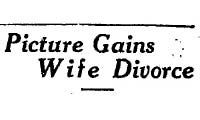
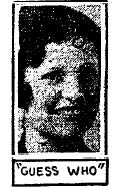
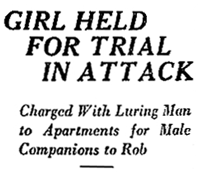

 August 19, 1927
August 19, 1927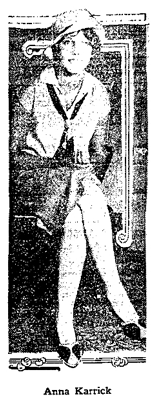 All the noir hallmarks here: a destitute, starry-eyed country girl, the shifty grifter she befriends, a rube with some dough in his pocket, a classic con, the crummy apartment hotel and a dark city.
All the noir hallmarks here: a destitute, starry-eyed country girl, the shifty grifter she befriends, a rube with some dough in his pocket, a classic con, the crummy apartment hotel and a dark city. place at
place at  532 South Fremont (now site of Glossy Black Tower, left) may be long gone, but it was a fun place while it lasted. In May 1929, Filipino nationals Cal Blanco and Ceferino Sandries argued over women with some sailors from the USS Colorado, when Blanco announced, “I’m going to kill all you sailors,” and so sailor Clyde Forehand shot them both dead; July of 1929 saw a riot there involving thirty sailors and six women, at which two women and seven men were booked on suspicion of robbery; Jack Wilson and Clark Falcon, leaders of a gang of automobile plunderers, were arrested with their booty here in February, 1932; in September 1935 Robert Honchell, a 25 year-old taxi driver, was having a drinking party with his pal Edward Folder, a 29 year-old unemployed café worker, when a woman showed up with her infant daughter—Folder’s insistence on taking the child out for candy started a quarrel, and Folder ended up stabbed mortally in the chest by Honchell…you get the idea.
532 South Fremont (now site of Glossy Black Tower, left) may be long gone, but it was a fun place while it lasted. In May 1929, Filipino nationals Cal Blanco and Ceferino Sandries argued over women with some sailors from the USS Colorado, when Blanco announced, “I’m going to kill all you sailors,” and so sailor Clyde Forehand shot them both dead; July of 1929 saw a riot there involving thirty sailors and six women, at which two women and seven men were booked on suspicion of robbery; Jack Wilson and Clark Falcon, leaders of a gang of automobile plunderers, were arrested with their booty here in February, 1932; in September 1935 Robert Honchell, a 25 year-old taxi driver, was having a drinking party with his pal Edward Folder, a 29 year-old unemployed café worker, when a woman showed up with her infant daughter—Folder’s insistence on taking the child out for candy started a quarrel, and Folder ended up stabbed mortally in the chest by Honchell…you get the idea.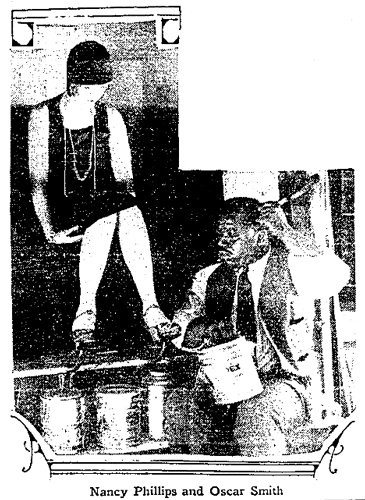
 You jazz-age dames sure make life tough for us workingmen! Oscar Smith, veteran bootblack at the Paramount Studio, has been compared by the Times to no less than a modern Rembrandt.
You jazz-age dames sure make life tough for us workingmen! Oscar Smith, veteran bootblack at the Paramount Studio, has been compared by the Times to no less than a modern Rembrandt. 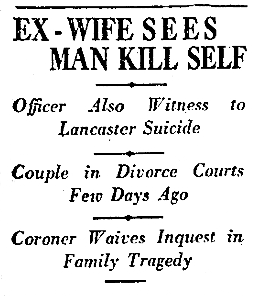
 August 18, 1927
August 18, 1927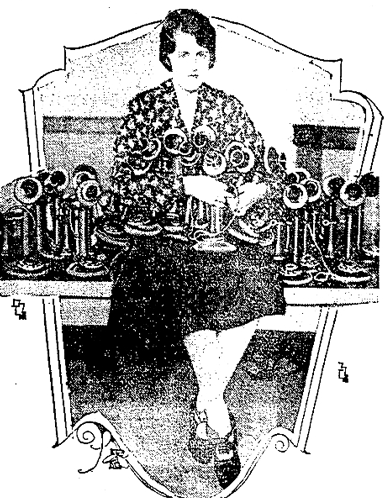
 The 192 square miles covered by the Los Angeles exchange are crissed and crossed by, interwoven and interlaced with 1.7 million miles of telephone line, servicing those 307,471 telephones upon which you Chatty Cathies of 1927 gab. (And that’s nearly double the 162,122 phones in service a mere five years ago in ’22.) With 1.2 million folk in LA, there’s roughly 25 phones per hundred persons.
The 192 square miles covered by the Los Angeles exchange are crissed and crossed by, interwoven and interlaced with 1.7 million miles of telephone line, servicing those 307,471 telephones upon which you Chatty Cathies of 1927 gab. (And that’s nearly double the 162,122 phones in service a mere five years ago in ’22.) With 1.2 million folk in LA, there’s roughly 25 phones per hundred persons.